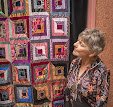A War Lord's Patchwork Coat
 |
| The Coat (Furisode) of Uesugi Kenshin (1530 -1578) |
In Japan, as in some other
cultures, patchwork garments were given as gifts. In those cases, the garment
would be made of the most expensive fabrics the donor could afford, since the
gift was a mark of respect. A patchwork coat from around 1560 and illustrated in Japanese Quilts by Jill
Liddell and Yuko Watanabe, for instance, is constructed from seventeen
different kinds of rare Chinese brocades. The coat dates from the Muromachi Period (1338-1573), a time when, due to the
financial burden of civil wars, domestic textile production diminished. As a
result, fabrics such as silks and brocades had to be imported from China so
were scarce and highly valued, and would have been available for consumption
only by the wealthy. This particular coat was presented as a gift to the famous war lord, Usuegi
Kenshin (1530 – 1578), who had vowed to
become a Zen-Buddhist and devoted to the Buddhist God of War, Bishamonten. Thus,
‘The use of patchwork would seem to be in accordance with the aesthetics of
Buddhist monks but the gorgeousness [would be] appropriate for his status as
one for the most important warlords of the time.’
